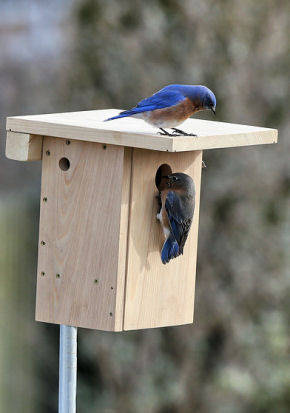
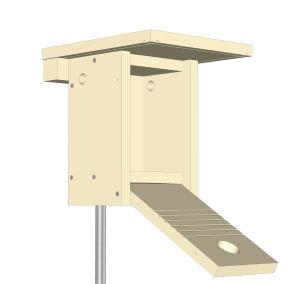
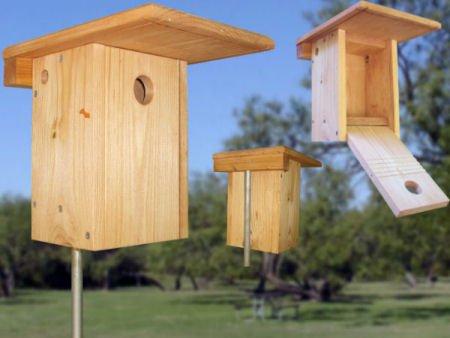

Featured nestbox
The Xbox for Bluebirds
by Tom Comfort
Antrim County Coordinator, Michigan Bluebird Society
Tom shares the development story of the Xbox along with some pearls of wisdom on nestbox design in general.
The Xbox for Bluebirds
by Tom Comfort
Antrim County Coordinator, Michigan Bluebird Society
Tom shares the development story of the Xbox along with some pearls of wisdom on nestbox design in general.
The Brains Behind the Xbox
• Dan Sparks (IN) NABS Board member and very active in several committees including the Hotline and the Website Sales. Dan is a District Coordinator for the Indiana Bluebird Society and heads the Brown County Bluebird Society in Indiana. Dan Sparks has a dedication to bluebirds that goes well beyond the term, "volunteer".
• Keith Radel (MN) Board member of the Bluebird Recovery Program of Minnesota (BBRP) and frequent guest speaker. Keith's 20 years of bluebird experience and his passion for bluebirds have contributed to the success of Rice County fledging over 5000 bluebirds/year. Keith is cocounty coordinator for Rice and Steele Counties.
• Kevin Berner (NY) Professor at the State University of New York (Cobbleskill, NY) Fisheries and Wildlife Faculty. Kevin is a Director in the New York State Bluebird Society, chairs the Research Committee, and he is the NABS Liaison. He was the former Research Committee Chairman for NABS when he served on the Board.
• Keith Kridler (TX) Keith is one of today's foremost authorities on bluebirds and co-author of The Bluebird Monitor's Guide (2001). He built his first nestbox in the 1960's and he may well have fledged more birds than any other single trail in North America. Keith's enthusiasm and experiences are highly valued among his peers.
• Steve Gilbertson (MN) Steve's friendship with Dick Peterson began his long career in nestbox design and construction. Since 1987, Steve has been building the Gilbertson PVC nestboxes and is very well known for his Gilwood nestbox. Steve may be the most significant contributor to bluebird recovery in North America. His innovation and dedication has turned bluebirders to predator resistant nestboxes and conduit mounting to discourage climbing predators, greatly improving their success.
• Steve Eno (NE) The Bluebirds Across Nebraska (BAN) organization is unparalleled in North America. Steve is the Executive Director of BAN and chairs the fund raising efforts. BAN's membership and volunteers are truly remarkable in their enormous success in growth and frequent success in fledging record numbers of bluebirds each year. Steve and his wife Cheryl are tireless in their drive and enthusiasm for bluebirds in Nebraska, or anywhere the help is needed.
• Tom Comfort (MI) Tom is a recent bluebird enthusiast. His interest in building nestboxes led him to meet some of the finest bluebirders in the country. He became a NABS Board member to gain more experience and contribute. A life member of MBS, BAN and BBRP, Tom hopes to make a difference in the bluebird recovery efforts.
• Dan Sparks (IN) NABS Board member and very active in several committees including the Hotline and the Website Sales. Dan is a District Coordinator for the Indiana Bluebird Society and heads the Brown County Bluebird Society in Indiana. Dan Sparks has a dedication to bluebirds that goes well beyond the term, "volunteer".
• Keith Radel (MN) Board member of the Bluebird Recovery Program of Minnesota (BBRP) and frequent guest speaker. Keith's 20 years of bluebird experience and his passion for bluebirds have contributed to the success of Rice County fledging over 5000 bluebirds/year. Keith is cocounty coordinator for Rice and Steele Counties.
• Kevin Berner (NY) Professor at the State University of New York (Cobbleskill, NY) Fisheries and Wildlife Faculty. Kevin is a Director in the New York State Bluebird Society, chairs the Research Committee, and he is the NABS Liaison. He was the former Research Committee Chairman for NABS when he served on the Board.
• Keith Kridler (TX) Keith is one of today's foremost authorities on bluebirds and co-author of The Bluebird Monitor's Guide (2001). He built his first nestbox in the 1960's and he may well have fledged more birds than any other single trail in North America. Keith's enthusiasm and experiences are highly valued among his peers.
• Steve Gilbertson (MN) Steve's friendship with Dick Peterson began his long career in nestbox design and construction. Since 1987, Steve has been building the Gilbertson PVC nestboxes and is very well known for his Gilwood nestbox. Steve may be the most significant contributor to bluebird recovery in North America. His innovation and dedication has turned bluebirders to predator resistant nestboxes and conduit mounting to discourage climbing predators, greatly improving their success.
• Steve Eno (NE) The Bluebirds Across Nebraska (BAN) organization is unparalleled in North America. Steve is the Executive Director of BAN and chairs the fund raising efforts. BAN's membership and volunteers are truly remarkable in their enormous success in growth and frequent success in fledging record numbers of bluebirds each year. Steve and his wife Cheryl are tireless in their drive and enthusiasm for bluebirds in Nebraska, or anywhere the help is needed.
• Tom Comfort (MI) Tom is a recent bluebird enthusiast. His interest in building nestboxes led him to meet some of the finest bluebirders in the country. He became a NABS Board member to gain more experience and contribute. A life member of MBS, BAN and BBRP, Tom hopes to make a difference in the bluebird recovery efforts.
Home | Site Map | Disclaimer | Contact Us
Copyright © 2012 NestboxBuilder.com
This site was last updated on 01/01/2016
Copyright © 2012 NestboxBuilder.com
This site was last updated on 01/01/2016
Dick Peterson, creator of the "Peterson Nestbox," a highly successful nestbox design that numbers in the hundreds of thousands in distribution, is too complex for a simple trail box. In Dick Peterson's book, Bluebirds (1991), there is a chapter - "A Good Nest Box." It lists "The Basics of Nest Box Design" and I quote:
"A good box must offer protection against the elements…
"Drafty houses won't allow bluebirds to keep the eggs warm…"
"Ventilation above the nest is key to safe temperature control…"
"To keep water out of the box, the holes should be protected against wind-driven rains."
"A good box must be easy to open for monitoring."
"The box should be as predator-proof as is practical."
Dan suggested a committee or task-force of highly experienced Bluebirders with knowledge of the pros and cons of nestbox design and construction. (see side-bar later in the article for their names. I am a new Bluebirder and honored to be included). The seven member committee was enthusiastic and what could have been a long and laborious process, actually moved swiftly. The vast experiences of the members meant that myths of nestbox design were dispelled and (most*) agreed on the basics of a new simple nestbox. *regional differences of weather and predator dominance meant that one nestbox can't fit all needs. Some members have different needs.
The plan was laid out: A simple nestbox (in design and construction), that is protective (from inclement weather and predators), easy to monitor, and attractive to bluebirds.
Steve Gilbertson, nationally known bluebird nestbox designer and builder, is one of the committee members. Steve has said that a good nestbox has to work in several ways.
"You need to have bird appeal first, the box has to be tight and dry, it must discourage predators, and it has to be easy to work with."
Dan led the group to discuss one issue at a time. Basically we followed the premise that this would be a simple nestbox that can be built with one-size board. And, we agreed to avoid angle cuts or design that would require complex construction. In order to be protective, the box needs to stay dry, not be drafty (and have the option to ventilate), be predator resistant and perhaps, even competitor resistant.
The one-board nestbox is based on dimensional lumber (1X6). We stayed with a flat roof (a larger board - 1X10) for simplicity. To keep the box dry, even if the roof were to warp or split, an 'inner' roof/ceiling board was included. Basically, the box is built with this inner roof
and then the exterior roof is attached to provide protective overhang. This roof overhang is 4 inches as part of the predator and weather protection plan. Many successful nestboxes have used less overhang, but this was a simple and inexpensive plan to accept.
The floor does not include 'drains'. As Steve Gilbertson said, the box should be tight and dry. Keeping the water out of the nestbox is much more successful in protecting nestlings then attempts to 'drain' or dry a wet nest. Dick Peterson stressed avoiding drafts in the nest area, as well. (Both of these men are from MN and experience cold Spring nesting seasons)
The need to 'vent' a nestbox seems to be a very climatic/regional need. Keith Kridler needs a lot of venting in the Texas heat and Wisconsin Bluebirders avoid vents due to lethal black fly attacks. To vent or not to vent (?), was easily agreed to be done as needed with the caution to protect from rain, wind, cold, etc.
Predator resistance is also a regional challenge. We can be very successful in avoiding climbing predators with the Gilbertson's ½ inch conduit mounting pole system. I stress system because this nestbox, like many other successful boxes, was designed to use the conduit mount as part of the predator avoidance system.
The enormously successful Bluebirders in Nebraska (Bluebirds Across Nebraska or BAN) has embraced the Gilbertson 'conduit/re-bar' mounting system (along with much of MN).
Perhaps the most revolutionary committee consensus had little to do with the nestbox, but the support for predator resistant mounting. The success of the Gilbertson mounting system is prevalent in the mid-west. Michigan Bluebirders will really benefit from looking at nestboxes as a box and mounting system, if they are to succeed in predator avoidance.
This new box incorporated a (2x2) board across the back of the roof (similar to the Gilbertson PVC nestbox). This reduced roof warping, sealed the water out, and made the roof stronger to mount. The (2x2) is predrilled for ½ inch conduit mounting and received the enthusiastic endorsement of Keith Radel (BBRP). The box can be mounted in other ways but this system has been a turning point in predator avoidance. Some people like Dick Peterson, spent years trying to ward off the predators when they got to the box, but Steve Gilbertson looked at the problem differently. Why let predators get to the box?
For a nestbox to be "easy to work with," it must be easy to monitor and maintain. The group decided to use a front access and to hinge the front from the bottom. The 5-1/2 inch frontal opening permitted easy viewing of nests and nestlings.
For a nestbox to be attractive to bluebirds, there are some conflicting decisions to be made. Shallower nestboxes are believed to be more attractive to eastern bluebirds and less attractive to English House Sparrows. But, in Texas, (they) fear the long armed predators and opt for deeper nestboxes. In rather quick order, the committee (less 'Texas') accepted a shallower nestbox with a distance of 5 inches from the hole to floor. This distance is less than the older field boxes of NABS fame (Dr Zeleny and his predecessors in the 1930s) but more than some (the Troyer, Gilbertson and Gilwood are even shallower). All this was done for the sake of making nestboxes more 'attractive' to Bluebirds and less attractive to the English House Sparrow.
Apparently, bluebirds like large entry holes (like the famous Gilwood) but that could permit competitors if not designed with care. The committee quickly decided to use a round hole, but they also suggested a hole with 1- 9/16 inch diameter (over the old standard of 1-1/2inches). It may not seem significant, but this is about 8% larger opening and (apparently) well known to be more 'attractive' to bluebirds. It is also believed that the larger hole is still unattractive to the European Starling (especially with a shallower box).
The standard smaller hole is certainly an option and easier for those less equipped, but the larger entry is preferred by eastern bluebirds. The BBRP (MN Bluebird Recovery Program, Audubon Chapter of Minneapolis), suggests that the 1-9/16 diameter hole as the optimum size for round entries.
Finally, nestbox designs seem to be named for designers or creators of any given nestbox, but what should we name a nestbox designed by committee? Box "X," became the Xbox.
How well did the Xbox perform? Ninety-six boxes were used and distributed for trial last year. Participant comments are very helpful to evaluate the preliminary plan of this proto-type. In the end, the birds will be the final judge. Humans debate while the birds build nests and demonstrate their preferences, and we watch and learn from their experiences.
The Xbox is hoped to be a very good, simple 'trail box'. It is inexpensive and easy to make. The BBRP suggests selecting a "durable, waterproof nestbox, …that is easy for you to open for weekly checking." The vast experience of the (others) in the design committee, has (hopefully) resulted in a nestbox that is attractive to bluebirds and is a dry and safe nesting environment. So far, the Xbox appears to be easy to work with. The Xbox plan is flexible to meet the extremes of climate, habitat and varied predators and competitors found in different regions.
Change usually comes slowly, but I believe that the Xbox is making history as a good, safe, simple trail-box. Thanks to all that are helping and contributing to this effort.
"A good box must offer protection against the elements…
"Drafty houses won't allow bluebirds to keep the eggs warm…"
"Ventilation above the nest is key to safe temperature control…"
"To keep water out of the box, the holes should be protected against wind-driven rains."
"A good box must be easy to open for monitoring."
"The box should be as predator-proof as is practical."
Dan suggested a committee or task-force of highly experienced Bluebirders with knowledge of the pros and cons of nestbox design and construction. (see side-bar later in the article for their names. I am a new Bluebirder and honored to be included). The seven member committee was enthusiastic and what could have been a long and laborious process, actually moved swiftly. The vast experiences of the members meant that myths of nestbox design were dispelled and (most*) agreed on the basics of a new simple nestbox. *regional differences of weather and predator dominance meant that one nestbox can't fit all needs. Some members have different needs.
The plan was laid out: A simple nestbox (in design and construction), that is protective (from inclement weather and predators), easy to monitor, and attractive to bluebirds.
Steve Gilbertson, nationally known bluebird nestbox designer and builder, is one of the committee members. Steve has said that a good nestbox has to work in several ways.
"You need to have bird appeal first, the box has to be tight and dry, it must discourage predators, and it has to be easy to work with."
Dan led the group to discuss one issue at a time. Basically we followed the premise that this would be a simple nestbox that can be built with one-size board. And, we agreed to avoid angle cuts or design that would require complex construction. In order to be protective, the box needs to stay dry, not be drafty (and have the option to ventilate), be predator resistant and perhaps, even competitor resistant.
The one-board nestbox is based on dimensional lumber (1X6). We stayed with a flat roof (a larger board - 1X10) for simplicity. To keep the box dry, even if the roof were to warp or split, an 'inner' roof/ceiling board was included. Basically, the box is built with this inner roof
and then the exterior roof is attached to provide protective overhang. This roof overhang is 4 inches as part of the predator and weather protection plan. Many successful nestboxes have used less overhang, but this was a simple and inexpensive plan to accept.
The floor does not include 'drains'. As Steve Gilbertson said, the box should be tight and dry. Keeping the water out of the nestbox is much more successful in protecting nestlings then attempts to 'drain' or dry a wet nest. Dick Peterson stressed avoiding drafts in the nest area, as well. (Both of these men are from MN and experience cold Spring nesting seasons)
The need to 'vent' a nestbox seems to be a very climatic/regional need. Keith Kridler needs a lot of venting in the Texas heat and Wisconsin Bluebirders avoid vents due to lethal black fly attacks. To vent or not to vent (?), was easily agreed to be done as needed with the caution to protect from rain, wind, cold, etc.
Predator resistance is also a regional challenge. We can be very successful in avoiding climbing predators with the Gilbertson's ½ inch conduit mounting pole system. I stress system because this nestbox, like many other successful boxes, was designed to use the conduit mount as part of the predator avoidance system.
The enormously successful Bluebirders in Nebraska (Bluebirds Across Nebraska or BAN) has embraced the Gilbertson 'conduit/re-bar' mounting system (along with much of MN).
Perhaps the most revolutionary committee consensus had little to do with the nestbox, but the support for predator resistant mounting. The success of the Gilbertson mounting system is prevalent in the mid-west. Michigan Bluebirders will really benefit from looking at nestboxes as a box and mounting system, if they are to succeed in predator avoidance.
This new box incorporated a (2x2) board across the back of the roof (similar to the Gilbertson PVC nestbox). This reduced roof warping, sealed the water out, and made the roof stronger to mount. The (2x2) is predrilled for ½ inch conduit mounting and received the enthusiastic endorsement of Keith Radel (BBRP). The box can be mounted in other ways but this system has been a turning point in predator avoidance. Some people like Dick Peterson, spent years trying to ward off the predators when they got to the box, but Steve Gilbertson looked at the problem differently. Why let predators get to the box?
For a nestbox to be "easy to work with," it must be easy to monitor and maintain. The group decided to use a front access and to hinge the front from the bottom. The 5-1/2 inch frontal opening permitted easy viewing of nests and nestlings.
For a nestbox to be attractive to bluebirds, there are some conflicting decisions to be made. Shallower nestboxes are believed to be more attractive to eastern bluebirds and less attractive to English House Sparrows. But, in Texas, (they) fear the long armed predators and opt for deeper nestboxes. In rather quick order, the committee (less 'Texas') accepted a shallower nestbox with a distance of 5 inches from the hole to floor. This distance is less than the older field boxes of NABS fame (Dr Zeleny and his predecessors in the 1930s) but more than some (the Troyer, Gilbertson and Gilwood are even shallower). All this was done for the sake of making nestboxes more 'attractive' to Bluebirds and less attractive to the English House Sparrow.
Apparently, bluebirds like large entry holes (like the famous Gilwood) but that could permit competitors if not designed with care. The committee quickly decided to use a round hole, but they also suggested a hole with 1- 9/16 inch diameter (over the old standard of 1-1/2inches). It may not seem significant, but this is about 8% larger opening and (apparently) well known to be more 'attractive' to bluebirds. It is also believed that the larger hole is still unattractive to the European Starling (especially with a shallower box).
The standard smaller hole is certainly an option and easier for those less equipped, but the larger entry is preferred by eastern bluebirds. The BBRP (MN Bluebird Recovery Program, Audubon Chapter of Minneapolis), suggests that the 1-9/16 diameter hole as the optimum size for round entries.
Finally, nestbox designs seem to be named for designers or creators of any given nestbox, but what should we name a nestbox designed by committee? Box "X," became the Xbox.
How well did the Xbox perform? Ninety-six boxes were used and distributed for trial last year. Participant comments are very helpful to evaluate the preliminary plan of this proto-type. In the end, the birds will be the final judge. Humans debate while the birds build nests and demonstrate their preferences, and we watch and learn from their experiences.
The Xbox is hoped to be a very good, simple 'trail box'. It is inexpensive and easy to make. The BBRP suggests selecting a "durable, waterproof nestbox, …that is easy for you to open for weekly checking." The vast experience of the (others) in the design committee, has (hopefully) resulted in a nestbox that is attractive to bluebirds and is a dry and safe nesting environment. So far, the Xbox appears to be easy to work with. The Xbox plan is flexible to meet the extremes of climate, habitat and varied predators and competitors found in different regions.
Change usually comes slowly, but I believe that the Xbox is making history as a good, safe, simple trail-box. Thanks to all that are helping and contributing to this effort.
This article first appeared in the The Bluebird Flyer
Article reprinted with permission from the Michigan Bluebird Society
Article reprinted with permission from the Michigan Bluebird Society
This sunny day we set the boxes on a new trail - and the Xboxes are the only ones that attracted bluebirds.
Steve Gilbertson of Aitkin, MN with a well-used Xbox
photo by Tom Comfort
In the winter of 2010, Dan Sparks, a veteran Bluebirder in Indiana, talked about his interest in a new "trail nest box." Dan was not alone in believing that the historically common nestboxes have some perceived failings. Most bluebird enthusiasts are familiar with the simple nestboxes that often have warped, leaky roofs. Some of these boxes can also be difficult to monitor. In short, over the years, knowledge and experience have reshaped the needs and desires for the illusive perfect nestbox. This is not about the perfect box.
The Xbox is a front-opening nestbox with a bottom pivoting door. Easy to build; all saw cuts are square - no bevels or angles.
An inner roof provides a second level of protection if the main roof warps or splits.
You can download a copy of the Xbox plan from our plans page, or click on the link below
Download plan 226kb (pdf)
Download plan 226kb (pdf)
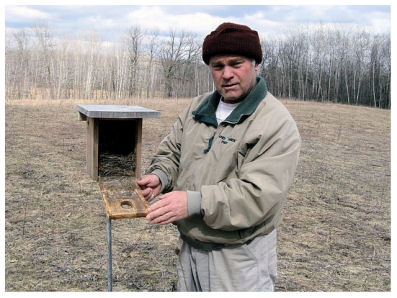
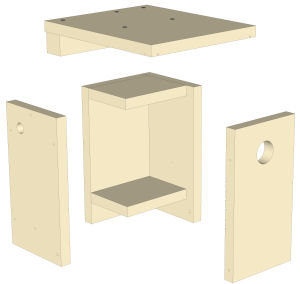
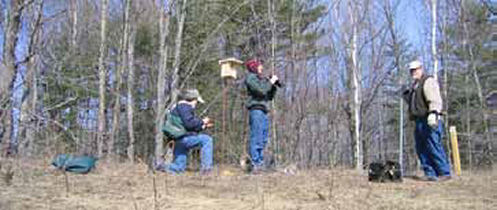
A pair of Eastern Bluebirds investigate an Xbox.
Photo by David Kinneer
